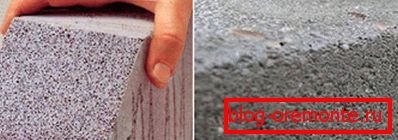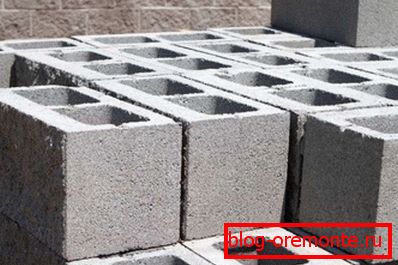Cellular concrete - properties, types, production and
Not only heavy concretes are used in construction, but also light ones, the structure of which is distinguished by its porosity. This makes it possible to spend less on building insulation. But, this feature is only one of the characteristics of such a material, and that it is cellular concrete, its properties and application will be discussed in the article below.

Let's see
As mentioned above - this is one of the varieties, the so-called lightweight concrete. In fact, it is an artificial building material that has a porous or cellular structure. In its manufacture, mineral substances are used as binders, and silica compounds are used as filler.
The main use of such concretes is thermal insulation of structures.
For example, they are actively used for insulation:
- attic and reinforced concrete floors;
- wall constructions, when used as a “layer cake”.
Tip: in contrast to conventional concretes, where for the dismantling of structures it is necessary to cut reinforced concrete with diamond circles, in this case, treatment can be carried out with ordinary hacksaws and simple tools.
There are also heat-resistant types of porous concrete, which have shown themselves well as thermal insulation of industrial equipment that performs work at temperatures up to 700? C.

In civil engineering, blocks of it have recently also begun to increasingly attract the attention of developers as a material for building walls.
You can confidently say that:
- country houses;
- townhouses;
- cottages;
built with the use of this material have thermal characteristics that significantly exceed the parameters of brick houses or concrete of another type.

Production
It was possible to achieve such indicators mainly due to the correct geometry of the building blocks. Their sizes have an insignificant error, within ± 2 mm, allowing the use of special construction glue during their installation, the layer of which does not exceed 3 mm. If we compare the same indicators of other materials for walls, where cement mortar is used for laying, they are much higher.
Production of lightweight concrete is regulated by GOST for cellular concrete 25485-89, which means "standard", and cellular concrete according to GOST 31360 2007 - "non-reinforced autoclave".
The above standards allow to classify the material by:
- use;
- the method of pouring;
- binder;
- the appearance of the silica component;
- hardening method.

You can select light concretes of the following types, depending on the functional use:
| Thermal insulation | It is applied as heat-insulating construction material. Its bulk density is 300-500 kg / m3. |
| Constructional | With its help, it is possible to manufacture structural elements of buildings of various types. In this case, the bulk density of the material - 1-1.2 t / m3. |
Apply and structural heat-insulating concrete, in which the bulk density - 500-900 kg / m3. The density of cellular concrete primarily depends on the amount of blowing agent. Porosity is the pore-forming ability of the latter.
The types of concretes are also distinguished according to the method of porisation:
- aerated cellular silicate and aerated cellular concrete;
- gas silicates and aerated concrete;
- foam silicates and foam concrete.

In addition to the above-mentioned methods of porisation, in the manufacture of concrete, their individual modifications are also used, in particular:
- gas-foam technology, where the basics of gas formation and aeration method are combined;
- mass swelling by gas formation in an airless environment;
- using pressure to aerate the mass.
What do they do
In the manufacture of cellular concrete used different binding components, including:
- cement;
- lime;
- gypsum.
Also, the production may differ in the used silica components, of which there are:
- metallurgical slags;
- the hall;
- quartz sand.

Types
If we take into account the conditions of hardening cellular concrete, then we can distinguish:
- autoclavewhich harden under pressure exceeding atmospheric in the environment of saturated steam;
- non-autoclaved - solidifying in natural conditions, when using saturated steam at normal atmospheric pressure or using electric heating.
Tip: great difficulties in drilling cause concrete goods, in most cases, only diamond drilling of holes in concrete with professional crowns can come to the rescue. Lightweight concrete can be drilled with a conventional drill, even with a manual rotary drill.
Details on the types of cellular concrete
According to the text above, the basic terms “cellular concrete”, “gas concrete”, “foam concrete” and several others were introduced into circulation. However, even that material is not enough, especially for those who do not have building skills and relevant education, in order to understand everything correctly. Therefore, below we will try to explain in more detail, so to speak, "on the fingers."
In fact, all of the above materials, whatever they are called, can be combined with one term - “cellular concrete”. So designate the whole group of building materials that have the same specific properties. In this case, such a feature is the structure reflected in the name of the material. Inside them there are pores or cells that allow talking about them - porous or cellular.
The material in terms of performance and physico-mechanical characteristics is ordinary concrete, only foamed. Due to the fact that its structure is porous, it has a lower density, which significantly affects the mass of products made from it in a smaller direction. Therefore, a group of such concretes is called light.

The main types of cellular concrete can be considered as aerated concrete and foam concrete. Their names are determined depending on the production technology of finished materials. Also, the concepts of non-autoclave and autoclave have been introduced from the method of manufacturing cellular concrete.
Properties of foam concrete
- In this case, the technology makes it possible to produce material practically near the construction site, and this can be done independently.
- Equipment is purchased in hardware stores or rented if you don’t plan to build anything further. Thus, the price of works will decrease, and it will be possible to save money on the repair and maintenance of mechanisms.

- Installation for the production of foam concrete, depending on the power, is able to deliver building materials to a height of about 30 m. Such equipment will easily fit on the construction site, thus you will be able to carry out not only monolithic, but also block construction.
- Formwork or cutting technology can be used for the manufacture of blocks. The accuracy of the dimensions will depend on the capabilities of the equipment and the quality of the forms.
Before you start producing foam concrete, learn about its shortcomings:
- material when drying gives greater shrinkage;
- due to the item above the unit may crack;
- density loses aerated concrete;
- the grid is necessary for carrying out plaster works.
Properties of aerated concrete
- The material has a small pore size.
- It is produced at the factory equipment and brought to the construction site as a finished product. The instruction forbids to produce it in other conditions, and this is impossible.

- A certificate of quality is issued for each batch, which guarantees the buyer the correct overall dimensions of the products. For example, with the production technology of autoclaved concrete, blocks are produced with an accuracy of up to 1 mm.
Remember that the main characteristics - strength and density of concrete products are not related to themselves. We can not say that the denser the gas, so it is stronger.
But, when choosing, one should pay attention to these indicators:
- heat conductivity depends on density;
- from strength - bearing capacity.

Modern application
Today, artificial building materials are increasingly in demand among consumers. This is due to the easy processing of products, since natural is more difficult to process and transform.
At the same time, the material created by own hands does not have such negatives and improves its characteristics every year. Thanks to new research, it became possible to get not only the best performance properties, but also to increase the efficiency of their application.

Thermal insulation properties
No one doubts that cellular concrete considerably surpasses ordinary concrete in its thermal insulation properties. Even a schoolboy who was interested in the course of elementary physics in an educational institution can explain this — the pores inside the material contain air, which is a reliable heat insulator.
As a result, a house built with the use of aerated concrete or aerated concrete will be much warmer than a house built of wood or brick.
But, nevertheless, for a greater understanding it is necessary to explain a few points:
- Buildings made of wood or brick will also be warm.
- But, the actual question is - how much energy will have to be spent on space heating?
If we proceed from the calculations of experts, the cost of heat in the house of cellular concrete will be significantly less. For example, with equal amounts of energy consumed for heating a building, you will need to make the wall thickness of gas or foam concrete about 500 mm, at the same time a brick wall will be about 2 m.
Wooden and brick houses require the use of additional insulation, and therefore increases the estimate for the construction of the entire building, making porous concrete the best in competitive terms. If we proceed from the calculations of professionals, the use of the latter reduces the financial expenses for heating the premises of the house by almost 40%.
Tip: using these concretes, you can create a good sound barrier from the street, due to the cellular structure of the material.
Although the structures of cellular concrete are read stone, the microclimate created inside the building is close to the atmosphere of a wooden house. This is due to the ability of gas foam concrete to "breathe", in contrast to ordinary concrete and brick building materials.
It should be said that cellular concretes contain only mineral elements, which does not allow them to rot. They are environmentally friendly and do not contain harmful toxic substances that can damage our health and the environment.

disadvantages
Experts recommend not to build the use of cellular concrete in the priorities, as each modern material has its own distinct place of use. Therefore, they are not ideal, they also have their weak points.
One of them - the requirement of protection from the environment, as the wind and moisture, constantly falling into the pores, in the end will lead to their destruction. Therefore, when using cellular concrete for the construction of walls, it will not be superfluous to conduct external cladding.
Conclusion
The article described in detail what is autoclaved cellular concrete and non-autoclaved, the characteristics of the material were told, and why it is better to use it. In fact, you learned the goals and objectives of the production of these products, what goal the developers set for themselves, and which they were able to realize.
In addition to the positive feedback, there were also noted material defects, as well as how they can be eliminated during the construction of the house. The video in this article will help you find additional information on this topic.